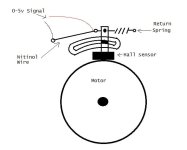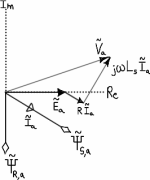BillMckraken
1 mW
Hello
First off I would just like to say hello! I'm new to the forum (have been reading for a while) and am looking into powered bikes. I do have several questions on E-bikes that I will start another thread for. I am just amazed at how much shear information is on this site. Also, there are some wonderful builds and builders here, great job all!
Anyhow, from reading I did come up with some ideas that may help the guys doing external brushless sensors. It seems (maybe with optical) these systems are providing benefits for their intention; e.g. startup, max rpm, efficiency etc . So, along those lines, I see your next step is to get a timing advance on the sensors if possible. I have a couple thoughts that may work. It's not something I will be jumping on as I haven't decided my setup; however I thought could possibly help someone already there.
Okay, the first version is a hydrodynamic timing advance. This one is a bit easier in concept than carry-out however would be extremely accurate based on RPM.

As this is my first time posting,....i hope you see a pic above here, lol.
The photo should help explain the idea here. First you have an impeller mounted to the motor shaft (prolly back on a turnigy) shown in blue. Encasing this and bearing supported on shaft is the Advance drive. You can see it has veins opposing the shown motor rotation. The Hall / Opto sensor would be hard mounted to the Advance drive along with a return spring. Most likely you would want a spring stop for 0 advance. What you end up with, is an extremely loosely coupled drive. The unit should be sealed and filled with a light weight oil, but you could use air also. As the motor spins faster the energy from the impeller is transferred to the Advance drive by the viscous properties of the fluid medium. On the plus side you can very accurately transfer a percentage of energy to the timing advance. A good and bad thing is viscosity; higher means easier design, lower means faster response.
k, nuff of that one.
The second idea I had for controlling the timing advance, is with Titanium Nitinol wire (memory wire). Guess I'll show the pic first here too.

I used this stuff back when I had a marine store (2000ish), it was fairly new then. The advantage to this system would be a fairly quick and accurate advance; also very durable. In all cases Nitinol wire is affected, ultimately, by temperature; however when used as an actuator this heat is often supplied electrically. For an actuator and Nitinol, when heated the wire will shrink in proportion to the amount of heat it achieves e.g. Watts. The longer the wire, the more it will shrink in length. The higher its' temperature, the shorter it will be (to it's max per length). Once the wire has shorted it will not return to its' original length on it's own. A return spring must be added to stretch the wire back. Here you could run a voltage compared signal (based on motor V or throttle %) that would heat and shorten (advance timing) the wire as power was applied. When I used these I had to parallel 5 wires to get my pull force (5lbs if I remember), but here 1 should do fine.
The good thing is, the wire can shorten very quickly and it doesn't take much power to do so. The down side is there is a slight delay in the spring return. A point of note though, the less force it takes to pull the sensor; the more force the spring can have and thus will return faster.
Sorry for the crummy Paint photo's . Figured an image would explain it all beter.
. Figured an image would explain it all beter.
I hope this may help or give ideas to those pondering timing advance, as well.
I'm sure I'll be posting soon with questions on trying an E-bike. Just wanted to try and offer something first.
Thanks
First off I would just like to say hello! I'm new to the forum (have been reading for a while) and am looking into powered bikes. I do have several questions on E-bikes that I will start another thread for. I am just amazed at how much shear information is on this site. Also, there are some wonderful builds and builders here, great job all!
Anyhow, from reading I did come up with some ideas that may help the guys doing external brushless sensors. It seems (maybe with optical) these systems are providing benefits for their intention; e.g. startup, max rpm, efficiency etc . So, along those lines, I see your next step is to get a timing advance on the sensors if possible. I have a couple thoughts that may work. It's not something I will be jumping on as I haven't decided my setup; however I thought could possibly help someone already there.
Okay, the first version is a hydrodynamic timing advance. This one is a bit easier in concept than carry-out however would be extremely accurate based on RPM.

As this is my first time posting,....i hope you see a pic above here, lol.
The photo should help explain the idea here. First you have an impeller mounted to the motor shaft (prolly back on a turnigy) shown in blue. Encasing this and bearing supported on shaft is the Advance drive. You can see it has veins opposing the shown motor rotation. The Hall / Opto sensor would be hard mounted to the Advance drive along with a return spring. Most likely you would want a spring stop for 0 advance. What you end up with, is an extremely loosely coupled drive. The unit should be sealed and filled with a light weight oil, but you could use air also. As the motor spins faster the energy from the impeller is transferred to the Advance drive by the viscous properties of the fluid medium. On the plus side you can very accurately transfer a percentage of energy to the timing advance. A good and bad thing is viscosity; higher means easier design, lower means faster response.
k, nuff of that one.
The second idea I had for controlling the timing advance, is with Titanium Nitinol wire (memory wire). Guess I'll show the pic first here too.

I used this stuff back when I had a marine store (2000ish), it was fairly new then. The advantage to this system would be a fairly quick and accurate advance; also very durable. In all cases Nitinol wire is affected, ultimately, by temperature; however when used as an actuator this heat is often supplied electrically. For an actuator and Nitinol, when heated the wire will shrink in proportion to the amount of heat it achieves e.g. Watts. The longer the wire, the more it will shrink in length. The higher its' temperature, the shorter it will be (to it's max per length). Once the wire has shorted it will not return to its' original length on it's own. A return spring must be added to stretch the wire back. Here you could run a voltage compared signal (based on motor V or throttle %) that would heat and shorten (advance timing) the wire as power was applied. When I used these I had to parallel 5 wires to get my pull force (5lbs if I remember), but here 1 should do fine.
The good thing is, the wire can shorten very quickly and it doesn't take much power to do so. The down side is there is a slight delay in the spring return. A point of note though, the less force it takes to pull the sensor; the more force the spring can have and thus will return faster.
Sorry for the crummy Paint photo's
I hope this may help or give ideas to those pondering timing advance, as well.
I'm sure I'll be posting soon with questions on trying an E-bike. Just wanted to try and offer something first.
Thanks


